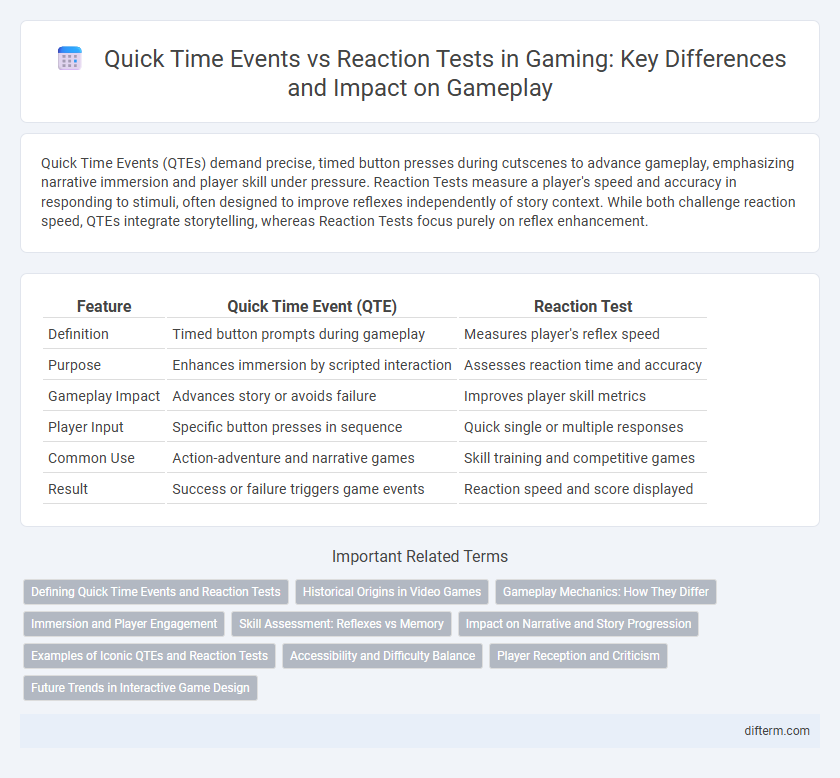Quick Time Events (QTEs) demand precise, timed button presses during cutscenes to advance gameplay, emphasizing narrative immersion and player skill under pressure. Reaction Tests measure a player's speed and accuracy in responding to stimuli, often designed to improve reflexes independently of story context. While both challenge reaction speed, QTEs integrate storytelling, whereas Reaction Tests focus purely on reflex enhancement.
Table of Comparison
| Feature | Quick Time Event (QTE) | Reaction Test |
|---|---|---|
| Definition | Timed button prompts during gameplay | Measures player's reflex speed |
| Purpose | Enhances immersion by scripted interaction | Assesses reaction time and accuracy |
| Gameplay Impact | Advances story or avoids failure | Improves player skill metrics |
| Player Input | Specific button presses in sequence | Quick single or multiple responses |
| Common Use | Action-adventure and narrative games | Skill training and competitive games |
| Result | Success or failure triggers game events | Reaction speed and score displayed |
Defining Quick Time Events and Reaction Tests
Quick Time Events (QTEs) are gameplay mechanics requiring players to press specific buttons within a limited time frame to successfully complete an action or avoid failure, often driving narrative or cinematic sequences. Reaction Tests measure a player's speed and accuracy in responding to stimuli, typically assessing reflexes through simple prompts without narrative influence. Both mechanics emphasize player responsiveness but serve distinct purposes in gaming experiences and design.
Historical Origins in Video Games
Quick Time Events (QTEs) first emerged in the early 1990s, notably popularized by games like "Shenmue" (1999) and "Resident Evil 4" (2005), where timed button prompts created cinematic tension and player engagement. Reaction Tests, rooted in arcade-style gameplay from the 1970s and 1980s, measure player reflexes through rapid input challenges without narrative overlay. Both mechanics evolved to enhance interactivity but diverge in origin, with QTEs integrating storytelling elements and Reaction Tests emphasizing raw response speed.
Gameplay Mechanics: How They Differ
Quick Time Events (QTEs) rely on scripted sequences where players must press specific buttons within a limited timeframe to succeed, emphasizing timed inputs linked to the game's narrative flow. Reaction tests measure a player's reflexes by requiring rapid responses to unpredictable stimuli, often outside story-driven contexts, focusing purely on raw reaction speed. Gameplay mechanics differ as QTEs integrate tightly with story progression and cinematic moments, whereas reaction tests serve as isolated challenges assessing player reflexes.
Immersion and Player Engagement
Quick Time Events (QTEs) heighten immersion by integrating cinematic sequences that require timely button presses, blending narrative with gameplay to maintain player engagement. Reaction Tests emphasize raw reflexes, offering repetitive challenges that enhance focus but may lack storytelling depth, potentially reducing overall immersion. Balancing QTEs and Reaction Tests can create a dynamic gaming experience that sustains player interest through both narrative involvement and skill-based interaction.
Skill Assessment: Reflexes vs Memory
Quick Time Events primarily assess reflexes by requiring players to respond swiftly to on-screen prompts, testing their hand-eye coordination and reaction speed. Reaction Tests evaluate players' memory and cognitive processing by presenting sequences or patterns that must be recalled and replicated accurately. Both methods provide distinct measures of skill, where Quick Time Events emphasize immediate physical response and Reaction Tests focus on short-term memory retention.
Impact on Narrative and Story Progression
Quick Time Events (QTEs) directly influence narrative flow by requiring players to perform timely actions that determine immediate story branches and character outcomes, creating a dynamic and immersive storytelling experience. Reaction tests emphasize player reflexes without altering the story's core path, thus maintaining narrative consistency but limiting player agency in shaping the plot. Games integrating QTEs often achieve higher emotional engagement through consequential choices, while reaction tests primarily challenge skill without affecting overall story progression.
Examples of Iconic QTEs and Reaction Tests
Iconic Quick Time Events (QTEs) such as the intense helicopter escape in "Resident Evil 4" or the dramatic lightsaber duel in "Star Wars: Jedi Fallen Order" showcase cinematic gameplay moments requiring precise timed inputs. In contrast, reaction tests like the rhythmic button presses in "Dance Dance Revolution" or the fast-paced tap sequences in "Osu!" focus on players' reflex speed and accuracy, challenging real-time responsiveness. Both mechanics engage players differently: QTEs integrate story-driven action sequences, while reaction tests emphasize pure reflex-based gameplay.
Accessibility and Difficulty Balance
Quick Time Events (QTEs) offer scripted prompts that can be calibrated for accessibility by adjusting input timing and visual cues, providing players with varying difficulty levels tailored to their reflexes. Reaction Tests demand rapid, precise responses without context, often posing higher accessibility challenges for players with motor impairments or slower reaction speeds. Balancing these mechanics involves fine-tuning input windows and feedback to maintain engagement while accommodating diverse player abilities, enhancing overall game inclusivity.
Player Reception and Criticism
Quick Time Events (QTEs) often receive mixed player reception due to their scripted nature, limiting player agency and leading to criticism about disrupting immersive gameplay. Reaction tests are praised for testing genuine reflexes and skill, fostering a more engaging and rewarding experience. However, both can frustrate players if overused or poorly integrated, impacting overall gameplay satisfaction.
Future Trends in Interactive Game Design
Quick Time Events (QTEs) are evolving with adaptive algorithms that tailor challenges based on player skill, enhancing engagement and immersion. Reaction Tests are integrating biometric feedback and machine learning to offer personalized difficulty adjustments and real-time performance analytics. Future trends in interactive game design emphasize seamless blending of QTEs and Reaction Tests to create dynamic, responsive gameplay experiences driven by player behavior and neuro-responsive technology.
Quick Time Event vs Reaction Test Infographic

 difterm.com
difterm.com